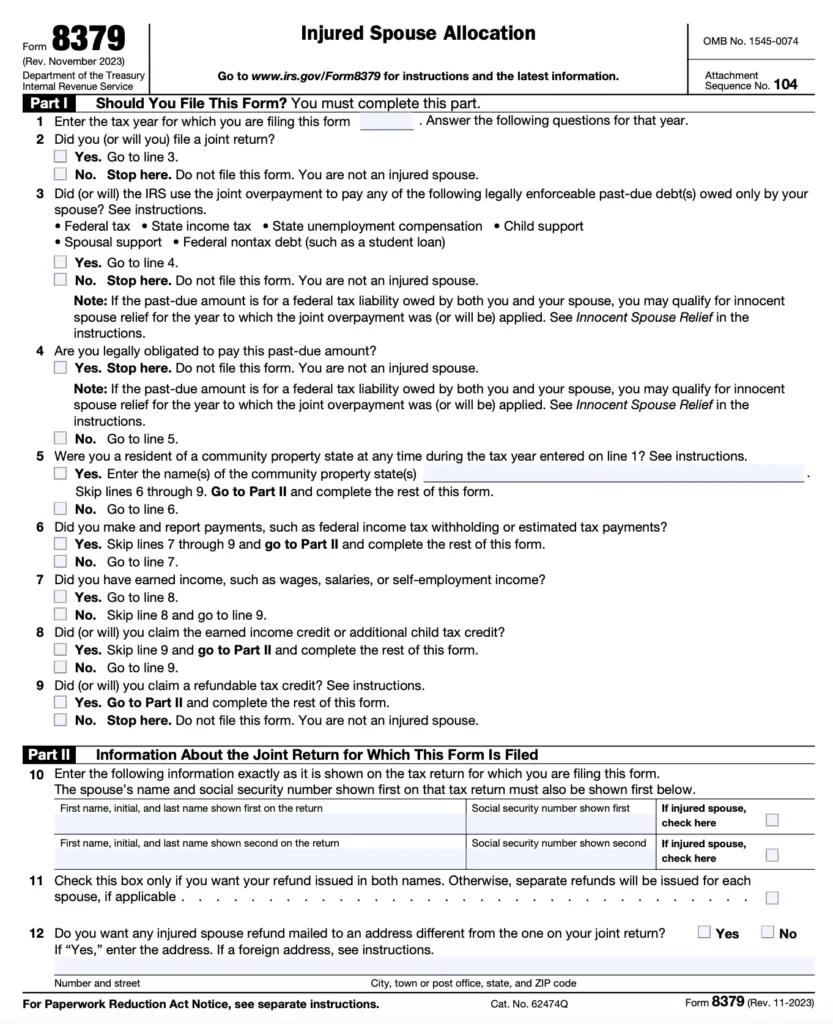IRS Form 8379 (Injured Spouse Allocation) allows you to claim your portion of a joint tax refund when your spouse’s past-due debts (like student loans, child support, or tax bills) would otherwise cause the IRS to withhold your entire refund.
Table of Contents
Who Should File Form 8379?
You may need to file if:
- You filed jointly with a spouse who owes federal/state debts
- You contributed income to the joint return (wages, investments, etc.)
- You want to protect your share of the refund
- Your refund was offset to pay your spouse’s debts
Note: This differs from “Innocent Spouse” relief. For complex cases, professional tax services can help determine which form you need.

Step-by-Step Guide to Completing Form 8379
Step 1: Gather Required Information
Before starting, collect:
- Your completed joint tax return (Form 1040)
- Both spouses’ Social Security Numbers
- Documentation of your income sources (W-2s, 1099s, etc.)
- Proof of state tax payments (if applicable)
- Any IRS notices about refund offsets
Step 2: Complete Part I – Personal Information
- Line 1a: Your full name (the injured spouse)
- Line 1b: Your SSN
- Line 1c: Spouse’s name and SSN
- Line 1d: Current address
Step 3: Complete Part II – Allocation Method
Choose one:
- Line 2a: Community property state residents
- Line 2b: Non-community property state residents
- Line 2c: Special allocation (attach explanation)

Step 4: Complete Part III – Income and Payment Allocation
- Line 3: Your wages, tips, and other earnings
- Line 4: Your business/self-employment income
- Line 5: Your other income items
- Line 6: Federal tax withheld from your income
- Line 7: Your share of estimated tax payments
- Line 8: Your share of refundable credits
Step 5: Complete Part IV – Special Situations
- Line 9: Additional explanations (if needed)
- Line 10: Prior-year amended return information
Step 6: Sign and Submit
- Both spouses must sign and date
- Attach to the front of your joint return
- Mail to the same IRS center where you file your 1040
Processing Time: Typically 8-14 weeks (11 weeks if e-filed with your return)
Common Mistakes to Avoid
- Filing after receiving your refund – Must be filed with the original return.
- Incorrect income allocation – Carefully separate community vs. separate property
- Missing signatures – Both spouses must sign
- Using the wrong form – Don’t confuse it with Form 8857 (Innocent Spouse)
For complex financial situations, professional tax services can ensure proper allocation.

Final Thoughts
Filing IRS Form 8379 properly can help you recover your rightful share of a joint tax refund when your spouse has outstanding debts. By following these steps and maintaining clear documentation of your income contributions, you can navigate this process successfully. For cases involving complex finances or disputes, professional tax services can provide valuable assistance and ensure your claim receives proper consideration.










